TYPES OF PAINT BRUSHES
All types of paint brushes are featured here as well as a brief description of their main purpose.
Thanks to Heinz Jordan & Company™ as well as Loew Cornell™ for supplying images of their fine line of art paint brushes.
We've also created a section for proper care and maintenance of your brushes. We hope you'll find the information useful.

Flats are the types of paint brushes you’ll use the most often in your painting projects. You’ll use them for basecoating, floating, strokework, blending, washes and varnishing.
As you can see, they’re very versatile.

A filbert is a flat brush but it has a chiseled rounded edge instead of a straight one. Sort of like a cat’s tongue. When you look at the brush from the chiseled edge, the hairs should form an even oval edge.
As a tool for basecoating, these types of paint brushes can't be beat! The shape of the hairs eliminates ridges. It can be used for side-loading similarly to a flat brush to create shades and highlights.
It's also used for blending. And because it can hold a fair amount of water, it’s also great for applying washes of color. And lastly, because of its shape it’s perfectly suited for doing leaves, flower petals and bird feathers.
Take a look at my video tutorial on how to use a Filbert.
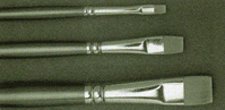
Also a part of the Flat family of brushes, the hairs here are much shorter. These types of paint brushes won’t hold enough paint for doing flowing strokes. They are very good though for blending paint, cleaning up messy edges and for other special techniques.

A brush by any other name..... This one is also a Flat but it has an angular chisel or brush tip. This means it will hold less paint and water, so you can’t get good continuous flow.
On the very positive side, this is THE brush for doing tight shading and highlighting. And it is especially coveted by artists who love to paint roses and flowers because they can get into all those little nooks and crannies. So, if you’re painting a realistic rose, consider trying this brush. But for long floats or strokework... not the right choice... best to use a flat.

These types of paint brushes come in many sizes; The smallest being a 20/0 and climbing all the way up to size #10. Mostly they are used for strokework and watercolor. This one is invaluable as a teaching tool for perfecting brush control.
Learning to use this brush for traditional strokework will provide a very strong foundation for all your painting efforts. Strokework is beautiful so mastering it is worth the time and practice.

These are part of the Round family of brushes. They range in size from 18/0 to #8. Another feature of liners is that they come in different lengths and thickness. This means that selecting the right liner can be challenging. The longer the hairs, the more paint and water the brush can carry.
The best advice is to try a variety of these types of paint brushes and stick to the ones that feel right for you and the task at hand.
A script liner has longer hairs than a regular liner, which makes it appropriate for doing fine lettering. By the way, using a script liner means you have to have a lot of brush control. It can be a little difficult to manage in tight curves because it tends to flick out. Practice, practice, practice!
Obviously a short liner will do great for small details like eyelashes. And a scroller will be ideally shaped for doing, you guessed it, scroll work.
The best memory is nothing
compared to a good brush.
- Old Chinese Proverb
As you can see there are so many types of paint brushes. For the beginner you only need a few of the most commonly used brushes to start.
But as you develop your craft, you’ll want to start dabbling in all sorts of different ways to paint. That’s when you’re ready to try all types of paint brushes.

The filbert rake is fun for creating hair, beards, feathers, fur, grass and woodgrain. It's a flat texturing brush with an oval, naturally fingered shape. Because of it's shape it offers softer edges than a flat rake.
When you're using either of the rakes you can choose to thin your paint depending on the effect you're trying to achieve. To get light texture just apply very little pressure. Don't overload the hairs with paint... the idea is to make sure that the bristles stay apart. Rakes are available in many sizes.

A mop brush is designed for gentle blending and softening. Used with a light touch, these types of paint brushes can quickly blur and soften a hard edge.
Mops come in a variety of shapes. Some resemble a make-up (blush) brush. Others are flatter and stiffer. These are the ones we prefer to use.
Mops are available in 1/4", 3/8", 1/2", 3/4", and 1".

Stipplers are the types of paint brushes used for creating fur and foliage and to give an open or soft general appearance to a painting. The stippler can be oval with flat, tidy bristles. Or it can be domed and round, as in this brush from Heinz Jordan.
It should be used dry. The amount of pressure you apply during the pouncing or stippling will determine the overall look and color value of your painting. They come in many sizes.
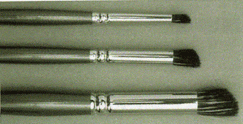
The deerfoot stippler is also a texturing brush used for creating fur and foliage. It's round and the bristles are long on the toe and short on the heel, bringing to mind the shape of Bambi's foot.
You should pick a deerfoot that has a lot of texture in its bristles over one that's stiff and neatly formed. You can use these brushes either wet or dry.
The amount of pressure you apply during the pouncing or stippling will determine the overall look and color value of your painting. They're available in 1/8", 1/4", 3/8", and 1/2".

The fan brush is flat with its bristles widely fanned out. It can be used dry to drag paint lightly across the surface of your painting. It can be used wet to create textures. And dragged through wet glazes it gives a fine wood-grain effect. Comes in a range of sizes.

These brushes require a little practice to use at first... it's like they're a filbert brush with half their bristles missing! They are terrific once you get the hang of them.
Truly a multi-purpose gem. You can load the brush with multiple colors, create great ribbons and petals and do stripes all in one fell swoop!
NEEDLE POINTED BRUSH
This artist paint brush is fairly new and funky looking! The needle pointed brush is a round with a long liner that extends through the end.
You can create some very interesting effects, especially great vines and twigs. Loaded with inky consistency paint, the round part acts as a reservoire and the liner is, well...a liner. By holding it almost perpendicular to the surface and using varying amounts of pressure, you'll have loads of fun with this one! It comes in Sizes #4, #6 and #8.
FANDANGO BRUSH
The Fandango brush...we just LOVE saying it... looks a bit like a fanned mop brush. This brush has long hairs with shorter ones in between. All hairs have very fine points on the ends. Not only does this brush hold lots of paint, but stroke it once on the surface and you've just made lots of fine lines. Great for creating grasses, fur, feathers and Santa's beards. Ready to Fandango?!
WHALE'S TAIL
The Whale's Tail...a flat brush with the bristles cut in a "V" shape which can be used for lots of one stroke effects. Loaded with two colors and fully pressed, results in a tulip shape. Change to green and three presses of the brush will give you an ivy leaf. It can also be used to create plaid, ribbon, layered petals and palm trees. Available in sizes, 1/4, 1/2, 3/4 and 1".
WAVE BRUSH
The Wave Brush, with scalloped bristle tips, comes in multiple sizes cut in Angular, Filbert and Flat shapes. There's a ton of stuff you can do with these brushes. Quick and easy strokes result in flower petals, leaves, simple birds, butterflies, woodgraining, eyelet lace and more. They can also be used to stipple light, airy foliage, and for some dry brushing techniques. Set your imagination in motion and have fun!!!
FOUNTAIN BRUSH
Another interesting brush shape, the Fountain Brush has a ring of bristles with a center opening. Loaded and spun in a circle gives you a quick rosette. Press down firmly for other interesting petal shapes. Also, try your hand at stippled foliage or fur and pulled strokes that create waterfalls and feathering.
Stay tuned as we will continue to bring you more information on all types of paint brushes such as stencil brushes, scruffies and scumblers.
If you'd like more information on all
all types of paint brushes, drop us a line here.
Let's leave Types Of Paint Brushes and go to Artist Paint Brushes.
Return to our Decorative Painting Home Page.
You Can Paint These Trees and More
Get Your Video Course Now
Introductory Price
Save 55% plus
a Money Back Guarantee
Site Search
| site search by freefind | advanced |
You Can Paint These Trees and More
Get Your Video Course Now
Introductory Price
Save 55% plus
a Money Back Guarantee
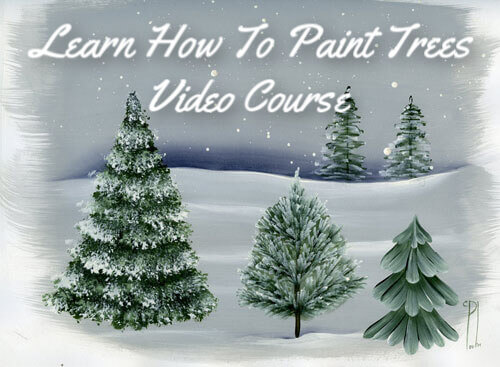
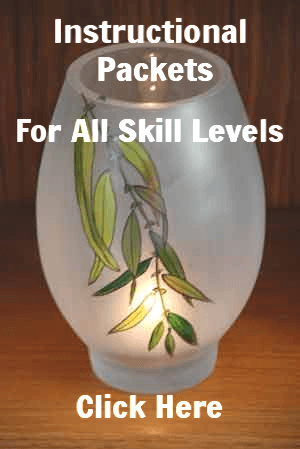



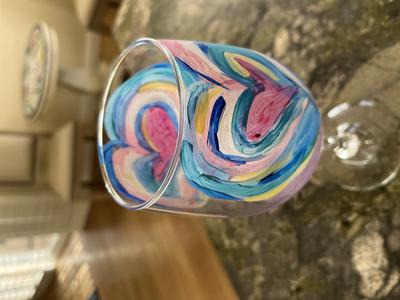

New! Comments
Have your say about what you just read! Leave me a comment in the box below.